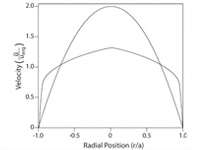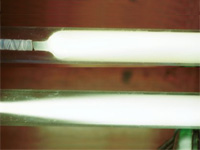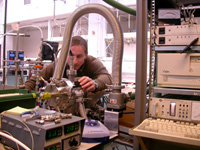Turbulent Flow Technique Chemical Ionisation Mass Spectrometer

The Turbulent flow technique is suitable for measuring elementary reactions over a wide range of pressures (70 - 600 Torr) and Temperatures (180 - 300 K). Unlike the conventional flow technique, the method operates under turbulent flow conditions. Turbulent flow is achieved by operating under fluid flow conditions with Reynolds numbers greater than 3000.
Working under turbulent flow conditions the plug flow approximation still holds and turbulent mixing by eddy diffusion allows the traditional versatility of flow tube methods to be regained when operating at higher pressures.
Furthermore the wall collision frequency for the reactants is greatly reduced in comparison with the conventional low pressure flow techniques which facilitates the study of gas phase kinetics at lower temperatures (180 - 300K).
The turbulent flow system is coupled to a chemical ionisation mass spectrometer (CIMS) for the detection of the radical species. The Chemical Ionisation Mass Spectrometer (CIMS) is a highly versatile and sensitive detector that has been used to monitor both stable and radical species in the laboratory such as HO2NO2, ClONO2, O3, HNO3, C2H5O2, C3H7O2, CH3O2 and HO2 at the ppt level. Unlike conventional electron impact mass spectrometers CIMS produces ions at high pressures (20-760 Torr). The main benefit of creating ions at high pressures is that ions can be focused by electrostatic lenses at each pumping stage and thus minimise loss of ion signal and enhancing sensitivity.
The use of a turbulent flow - CIMS (TF-CIMS) Enables radical reactions to be studied over a large range of pressures (70 - 760 Torr) and also facilitates the study of radical reactions at temperatures as low as 180 K. The highly sensitive CIMS detector allows kinetic studies to be undertaken at very low radical concentrations, typically (0.1 - 20) x 1010 molecule cm-3. Such low radical concentrations ensures that numerical modelling is not required to deconvolute the rate coefficient from the observed concentration-time profiles. Furthermore, the versatility of the CIMS detector enables the quantification of products as a function of temperature and pressure, thus allowing the mass balance of reactions to be verified.

